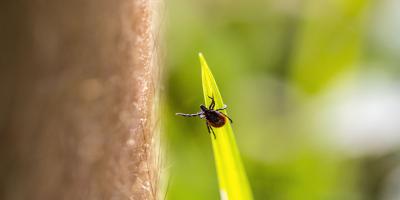Keep your Pets Tick-Free This Summer

With summer just around the corner, people aren’t the only ones ready to spend more time outdoors. Pets, too, are poised to fly the coop and get back out into nature. Unfortunately, a familiar threat that we all face when venturing out of the house is waiting for them, too: ticks.
Just like us, pets like cats and dogs are vulnerable to tick-borne illnesses. In fact, there are even a few diseases that affect them specifically, like American canine hepatozoonosis. And when it comes to ticks, pets have a pretty obvious complication that we humans don’t have to deal with -- they’re covered in thick fur, giving ticks lots of excellent places to hide and privately enjoy their meal.
Thankfully, all it takes to keep your fur-family members protected and free of ticks are just a few extra precautions on top of the preventative measures you already take for yourself.
Protection Options ‘Fur’ Pets Only
Dogs and cats have tick-prevention and elimination options that humans can’t use -- treatments like monthly oral medications, collars, powders, sprays and shampoos. The medications work by altering a natural element of the animal’s blood in a way that’s harmless to the animal but deadly to ticks (and, consequently, fleas). They both cure active infections and prevent future outbreaks.
Flea and tick collars work by emitting a gas that deters the insects. Some also contain a medication that is absorbed into the animal’s skin and poisons invasive insects (but not, obviously, your pet). Powders and sprays work similarly.
Finally, flea and tick shampoos contain ingredients toxic to parasites -- often similar to the medications used in lice shampoos that are manufactured for humans. These topical treatments kill invaders on contact but do not offer lasting protection.
Note that although many of these products use similar ingredients, it’s important to purchase a treatment that’s specific to either cats or dogs (or humans!) and only use it on the intended recipient. Formulas that may be safe for one species may irritate another and vice versa. And, of course, talk to your vet about which treatments are right for your pets. Some are only available by prescription.
Preventative Measures ‘Fur’ the Whole Family
Once you’ve decided on which pet-only treatments to use, the rest of your tick-prevention plan applies to everyone in your household. Before you leave the house, treat clothing and gear with products containing 0.5% permethrin (use an insect repellent containing either DEET or picaridin on yourself).
While out and about, avoid wooded or bushy areas with high grass or leaf litter and stick to the center of trails. Whenever you return from a trek through the outdoors, perform a tick-check on everyone, being sure to comb closely through hair and fur looking for little stowaways. On pets, be sure to look around their ears and eyes, under their collar, under and between both pairs of legs, between their toes, and around their tail.
Ticks: Silent, but Potentially Deadly
If the worst that could come of a tick bite were the annoyance of having to remove a parasite, these measures wouldn’t be of much consequence. However, ticks carry diseases that can be dangerous and sometimes deadly to both pets and humans, including the dreaded Lyme disease.
If your pet has been frolicking in nature unprotected against ticks, be wary of the signs of Lyme disease infection. Call your vet immediately if you notice your dog has these symptoms: fever, loss of appetite, reduced energy -- or especially lameness (even intermittent), stiffness or swelling of joints. Dogs get Lyme disease far more often, but cats exhibit the same set of symptoms as well and you should call your vet at the first sign of trouble.
One of the best ways to protect yourself, your family and your pets against ticks is to have your yard professionally treated. At JP, we make it easy and affordable to keep your yard tick-free all year long.



